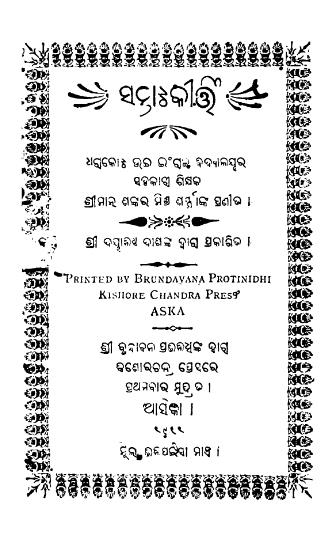In the rich tapestry of Odia literature, few works have achieved the level of acclaim and timeless relevance that Samratakirti, authored by the esteemed poet Shankara Misra, published in 1911, has garnered. This collection of poetry stands as a testament to Misra’s artistic brilliance and his profound understanding of human emotions, societal context, and the intricate relationship between man and nature. Through Samratakirti, Misra not only enchants readers with his lyrical prowess but also invites a deep contemplation of the themes that pervade his work.
The title Samratakirti, meaning The Glory of the Emperor, evokes a sense of nobility and grandeur. However, as one delves into its verses, it becomes evident that the glory Misra speaks of transcends royal achievements. It embodies the struggle for recognition, personal aspirations, and the quest for dignity in an ever-changing society. Each poem serves as both a celebration and a critique of the social structures that influence individual lives, making the collection a rich exploration of identity and purpose.
One of the striking features of Samratakirti is Misra’s exceptional command of language. His use of Odia is both sophisticated and expressive, allowing him to convey complex sentiments with clarity and beauty. The rhythmic quality of his poetry enhances its musicality, making it a delight to read aloud. Misra employs vivid imagery and poignant metaphors that evoke a range of emotions—from joy and love to sorrow and longing—capturing the essence of each moment he describes.
Nature plays a significant role in Misra’s poetry, often serving as a backdrop that reflects the inner turmoil of his characters. The landscapes of Odisha, with their lush greenery, rivers, and changing seasons, become metaphors for emotional states and social realities. Through his depictions of nature, Misra creates a powerful connection between the external environment and internal feelings, suggesting that the two are intertwined and that one’s surroundings can deeply influence personal experiences.
Additionally, Samratakirti addresses the theme of human resilience in the face of adversity. Misra imbues his poems with a sense of hope and determination, encouraging readers to embrace their struggles and seek empowerment. The message is particularly resonant in the context of the socio-political challenges faced during his time, as the country was grappling with colonial influences and searching for a renewed sense of identity. Misra’s poetry serves as a reminder of the strength that lies within individuals and communities, urging them to rise above their circumstances.
The cultural significance of Samratakirti cannot be overstated. In an era when the Odia language and literature were experiencing a renaissance, Misra’s work contributed to the ongoing dialogue about cultural identity and self-expression. His verses capture the spirit of Odisha, intertwining local traditions and values with universal themes, thus preserving and promoting the cultural heritage of the region.
As we reflect on the legacy of Samratakirti, it is evident that its relevance endures. The themes of identity, resilience, and the pursuit of glory resonate with readers across generations, offering insights that are both timeless and timely. In a world that often challenges our sense of self and purpose, Misra’s poetry reminds us of the importance of introspection and connection to our roots.
Books Info
| Books name | Samratakirti / ସମ୍ରାଟକୀର୍ତ୍ତି |
| Author | Shankara Misra |
| No Of pages | 68 |
| Publisher | Sri Dayananda Das |
| Publication | 1911 |
| Printed At | Kishore Chandra Press |
| Distributor | NA |

